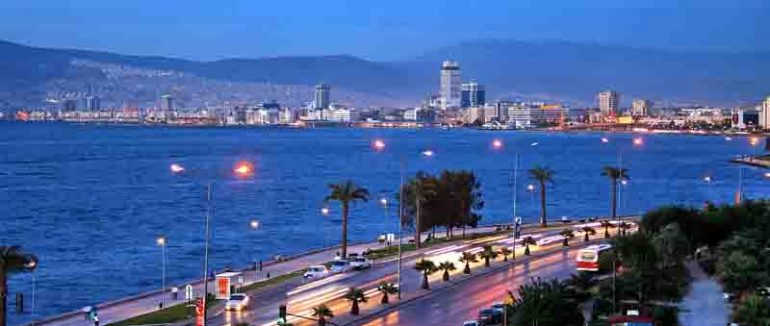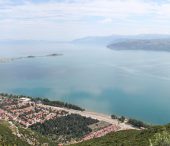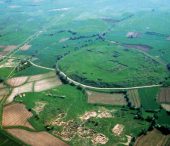İzmir, historically Smyrna, is the third most populous city of Turkey and the country's largest port after İstanbul. It is located in the Gulf of İzmir, by the Aegean Sea. It is the capital of İzmir Province. The city of İzmir is composed of 9 metropolitan districts (Balçova, Bornova, Buca, Çiğli, Gaziemir, Güzelbahçe, Karşıyaka, Konak, and Narlıdere), each with its own distinct features and temperament. The total population as of 2007 is 4168,415 is urban. The total area of the nine districts is 855 km².
İzmir has almost 3,500 years of urban past, and possibly that much more of advanced human settlement. It is Turkey's first port for exports and its free zone, a Turkish-U.S. joint-venture established in 1990, is the leader among the twenty in Turkey. Its workforce, and particularly its rising class of young professionals, concentrated either in the city or in its immediate vicinity (such as in Manisa), and under either larger companies or SMEs, affirm their name in an increasingly wider global scale and intensity. İzmir is widely regarded as one of the most liberal Turkish cities in terms of values, ideology, lifestyle, dynamism and gender roles. It is a stronghold of the Republican People's Party, although it lost a lot of ground to the ruling AKP party in the 2007 election.
The city hosts an international arts festival during June and July, and the İzmir International Fair, one among the city's many fair and exhibition events, is held in the beginning of September every year. It is served by national and international flights through Adnan Menderes Airport and there is a modern rapid transit line running Southwest to Northeast. İzmir hosted the Mediterranean Games in 1971 and the World University Games (Universiade) in 2005. It had a running bid submitted to the BIE to host the Universal Expo 2015, in March, 2008, that was lost to Milan. Modern İzmir also incorporates the nearby ancient cities of Ephesus, Pergamon, Sardis and Klazomenai, and centers of international tourism such as Kuşadası, Çeşme, Mordoğan and Foça.
Despite its advantageous location and its heritage, until recently İzmir has suffered, as one author puts it, from a "sketchy understanding" in the eyes of outsiders. When the Ottomans took over İzmir in the 15th century they did not inherit compelling historical memories, unlike the two other keys of the trade network, namely İstanbul and Aleppo. Its emergence as a major international port as of the 17th century was largely a result of the attraction it exercised over foreigners, and the city's European orientation. Very different people found İzmir attractive over the ages and the city has always been governed by fresh inspirations, including for the very location of its center, and is quick to adopt novelties and projects.
Names and etymology
The name of a locality called Ti-smurna is mentioned in some of the Level II tablets from the Assyrian colony in Kültepe (first half of the 2nd millennium B.C.), with the prefix ti- identifying a proper name, although it is not established with certainty that this name refers to İzmir. Some would see in the city's name a reference to the name of an Amazon called Smirna.
The region of İzmir was situated on the southern fringes of the "Yortan culture" in Anatolia's prehistory, the knowledge of which is almost entirely drawn from its cemeteries, and in the second half of the 2nd millennium B.C., in the western end of the extension of the yet largely obscure Arzawa Kingdom, an offshoot and usually a dependency of the Hittites, who themselves spread their direct rule as far as the coast during their Great Kingdom. That the realm of the local Luwian ruler who legated the 13th century B.C. Kemalpaşa Karabel rock carving at a distance of only 50 km from İzmir was called Mira may also leave ground for association with the city's name.
The oldest rendering in Greek of the city's name we know is the Aeolic Greek Μύρρα Mýrrha, corresponding to the later Ionian and Attic Σμύρνα (Smýrna) or Σμύρνη (Smýrnē), both presumably descendants of a Proto-Greek form *Smúrnā. It would be linked to the name of the Myrrha commifera shrub, a plant that produces the aromatic resin called myrrh and is indigenous to the Middle East and northeastern Africa. The Romans took this name over as Smyrna which is the name still used in English when referring to the city in pre-Turkish periods. The name İzmir (Ottoman Turkish: إزمير İzmir) is the modern Turkish version of the same name.
In Greek it is Σμύρνη (Smýrni), Իզմիր (Izmir) in Armenian, Smirne in Italian, and Izmir (without the Turkish dotted İ) in Ladino.
In English, the city was called Smyrna until the early twentieth century and has been called İzmir since. In written Turkish it is spelled with a dotted İ at the beginning.
İzmir is nicknamed "Occidental İzmir" or "The Pearl of the Aegean".
History
Ancient age
The city is one of the oldest settlements of the Mediterranean basin. The 2004 discovery of Yeşilova Höyük and the neighboring höyük of Yassıtepe, situated in the plain of Bornova, reset the starting date of the city's past further back than was previously thought. The findings of the two seasons of excavations carried out in Yeşilova Höyük by a team of archaeologists from İzmir's Ege University under the direction of Associate Professor Zafer Derin indicate three levels, two of which are prehistoric. Level 2 bears traces of early to mid-Chalcolithic, and the Level 3 of Neolithic settlements. These two levels would have been inhabited by the indigenous peoples of İzmir, very roughly, between 6500 to 4000 BC. With the seashore drawing away in time, the site was later used as a cemetery (several graves containing artifacts dating, roughly, from 3000 BC were found).
By 1500 BC the region fell under the influence of the Central Anatolian Hittite Empire. The Hittites possessed a script and several localities near İzmir were mentioned in their records. They are associated with the vestiges on top of the Mount Yamanlar overlooking the gulf from the northeast.
In connection with the silt brought by the streams that join the sea along the coastline of the gulf's end, the settlement that later formed the core of Old Smyrna was founded more to the north-west of the prehistoric settlement and on the slopes of the Mount Yamanlar, on a hill in the present-day quarter of Bayraklı where settlement is thought to stretch back as far as the 3rd millennium BC. The hill was possibly an island at the time or perhaps connected to the mainland by a very narrow isthmus. This İzmir preceding Old Smyrna was one of the most advanced cultures in Anatolia of its time and on a par with Troy. This phase of the city's history is also when it was associated with the Amazon Smirna. The presence of a vineyard of İzmir's Wine and Beer Factory on this hill, also called Tepekule, prevented the urbanization of the site and facilitated the excavations that started in the 1960s by Ekrem Akurgal.
However, in the 1200s BC, invasions from the Balkans destroyed Troy VII and Hattusas, the capital of the Hittite capital. Central and Western Anatolia fell back into a Dark Age that lasted until the emergence of the Phrygian civilization in the 8th century BC.
Iron Age houses were small, one-room buildings. The oldest house unearthed in Bayraklı is dated to 925 and 900 BC. The walls of this well-preserved one-roomed house (2.45 x 4 m) were made of sun-dried bricks and the roof of the house was made of reeds. Around that time, people started to protect the city with thick ramparts made of sun-dried bricks. From then on Smyrna achieved an identity of city-state. About 1,000 lived inside the city walls, with others living in near-by villages, where fields, olive trees, vineyards, and the workshops of potters and stonecutters were located. People generally made their living through agriculture and fishing.
Homer
Homer, referred to as Melesigenes which means "Child of Meles Brook" is said to have been born in Smyrna. Meles Brook is located within the city of İzmir and still carries the same name. Aristotle recounts: "Kriteis... gives birth to Homer near Meles Brook and dies after. Maion brings this child up and names him as Melesigenes ("Child of Meles") to emphasize the place where he was born." Six other cities claimed Homer as their countryman, but the main belief is that Homer was born in Ionia and combined with written evidence, it is generally admitted that Smyrna and Chios put forth the strongest arguments in claiming Homer.
From the 8th century BC
Old Smyrna
The term Old Smyrna is used to describe the Greek city-state of the classical era located at the urban settlement in Tepekule, Bayraklı, to make a distinction with Smyrna re-built later on the slopes of Mt. Pagos (Kadifekale today). The most important sanctuary of Old Smyrna was the Temple of Athena, restored somewhat today. The most ancient ruins preserved to our day date back to 725-700 BC.
Greek settlement in Old Smyrna is attested by the presence of pottery dating from about 1000 BC onwards. The city was settled at first by the Aeolians, but shortly thereafter seized by the Ionians and Smyrna was added to the twelve Ionian cities. As such, the city set out on its way to become one of the most prominent cultural and commercial centers of that period in the Mediterranean basin.
The period in which Old Smyrna reached its peak was between 650-545 BC. This period was considered to be the most powerful period of the whole Ionian civilization. Under the leadership of the city of Miletus, Ionian colonies were established in Egypt, Syria, the west coasts of Lebanon, the Marmara region, around the Black Sea and in eastern Greece. The colonies competed amongst themselves, and were a match for Greece proper in many areas. Smyrna by this point was no longer a small town, but an urban center that took part in the Mediterranean trade.
One of the most important signs of that period is the widespread use of writing beginning with 650 BC. There are many inscriptions on presentations of the gifts dedicated to the goddess Athena, whose temple dates to 640-580 BC.
The oldest model of a many-roomed-type house of this period was found in ancient Smyrna. Known to be the oldest house having so many rooms under its roof, this house was built in the second half of 7th century BC. The house has two floors and has five rooms with a courtyard. The houses before this type were composed of megarons standing adjacent to each other. Smyrna was built on the Hippodamian system in which streets run north-south and east-west and intersect at right angles. The houses all faced to the south.
This city plan, which took the name Hippodamus later in the 5th century BC, followed a pattern familiar in the Near East. The city plan in the Bayraklı Höyük (mound) is the earliest example of this type in the Western Hemisphere. The most ancient paved streets of the Ionian civilization have been discovered in ancient Smyrna.
The riches of the city impressed the Lydians and attracted them to Smyrna. The Lydian army conquered the city in about 610-600 BC and burned and destroyed parts of the city. Soon afterwards, another invasion, this time Persian, effectively ended Old Smyrna's history as an urban center of note. The Persian Emperor, determined to punish the cities that refused to give him support in his campaign against the Lydians, attacked the coastal cities of the Aegean after having conquered Sardis, the capital of Lydia. As a result, old Smyrna was destroyed in 545 BC.










